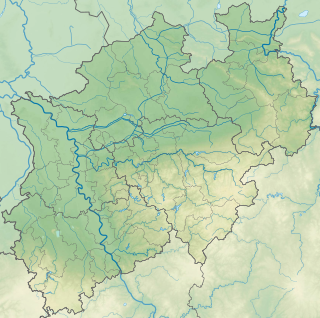Heckberg Forest
| Heckberg Forest | |||
|---|---|---|---|
| Systematics according to | Handbook of the natural spatial structure of Germany | ||
| Greater region 1st order | Low mountain range threshold | ||
| Greater region 2nd order | Rhenish Slate Mountains | ||
| Main unit group | 33 → Süderbergland |
||
| About main unit | 339 → Oberagger and Wiehltalland |
||
| Natural space |
339.3 → Heckberger Forest |
||
| Geographical location | |||
| Coordinates | 50 ° 57 '37.8 " N , 7 ° 24' 8.9" E | ||
|
|||
| local community | Engelskirchen , Much , Overath , Wiehl | ||
| state | North Rhine-Westphalia | ||
| Country | Germany | ||
The Heckberger Wald , also called the Heck or Im Heck , is a forest area at the border triangle of the Rhein-Sieg-Kreis , Rheinisch-Bergischer Kreis and Oberbergischer Kreis in North Rhine-Westphalia in the Bergisches Land , which is largely part of the last-mentioned district and also one of the largest contiguous forest areas in the Bergisches Land Nature Park .
At the same time, according to the handbook of the natural spatial structure of Germany , the Heckberg Forest is a natural spatial unit with the order number 339.3 and belongs to the higher-level natural area 339 ( Oberagger- and Wiehltalland ).
geography
location
The stern lies between Engelskirchen in the north, its district Ründeroth in the northeast, Bielstein in the east, Drabenderhöhe in the southeast, Much in the south, the Overather district Federath in the southwest and the Engelskirchen district Loope in the west. The highest elevation of the stern is at 383.4 m above sea level. NHN the Heckberg . With its western neighbor Kleiner Heckberg ( 348.1 m ) lies the highest point of the Rheinisch-Bergisches Kreis. To the north, the Agger flows - parallel to the federal motorway 4 there - in an east-west direction , and its tributary Naafbach rises on the southern edge .
Natural allocation
The forest area forms the sub-unit Heckberger Wald (339.3) in the natural spatial main unit group Süderbergland (No. 33) and in the main unit Oberagger- and Wiehltalland (339 ). To the north the landscape falls into the subunit Oberaggertal (339.1), and to the east and southeast it leads over into the subunit Wiehlbergland (339.2). In the neighboring main unit Bergische Hochflächen (338) the subunit Mucher Plateau (338.5) joins in the south, in the south-west in the subunit Agger-Sülz-Hochflächen (338.4) the natural area Marialinder Riedelland (338.43) and in the west-north-west the natural area Overather Aggertal ( 338.42).
Geology and landscape
The Heckberger Wald is a small, closed forest mountain range with strong relief energy that mainly drains north to the Agger. The subsoil of the knolls and the broadly sweeping mountain ranges is mainly formed by gray-wacke sandstone and quartzite . Notched valleys up to 150 m deep descend between the 300 and 380 m high elevations .
Most of the forest area is closed and has deciduous and mixed forest communities. A few clearing islands are settled in the form of hamlets, such as the Schalken belonging to Overath .
Mining
Mining was already practiced in the rear in Roman times. The Schalken copper mine dates back to the first half of the 2nd century. From 1838 to 1896, ore mining was carried out in the Silberkaule mine on the Heckberg .
Military use
The 55 hectare ammunition depot in Brächen was in the eastern part of the forest near Brächen . In addition to ammunition, other Bundeswehr material was also stored there. The depot was connected to the NATO pipeline via a pumping station and had a gas station, workshops, a heating plant, a water tank and a tall watchtower, which was blown up in 2005 for safety reasons. The area with its halls and security devices has been left to its own devices since 1996.
The foundations of a V1 launch pad from World War II are located near the depot.
Individual evidence
- ↑ Heinz Fischer: Geographical Land Survey: The natural spatial units on sheet 124 Siegen. Federal Institute for Regional Studies, Bad Godesberg 1972. → Online map (PDF; 4.1 MB)
- ↑ Thomas Grünewald: Germania Inferior - Reallexikon der Germanischen Altertumskunde , p. 538, Gruyter publishing house, 1st edition, 2000, ISBN 9783110169690 (English)
- ↑ a b Christoph Kämper: Ex-Mun.-Teilepot Brächen. April 2007, accessed November 5, 2016 .
